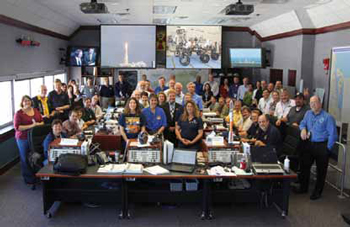NASA Renovates Radiological Control Center

If the most critical part of your mission lasts only 50 seconds, the right technology can make a big difference. When NASA launches a vehicle that includes a radioisotope power source, the first crucial seconds of the launch must be monitored carefully.
The entire RADCC team after the successful liftoff of the Mars Science Lab and “Curiosity.”
The job of NASA scientists became a lot easier starting November 26, when the Mars Science Lab and the rover “Curiosity” lifted off from the Kennedy Space Center. This vehicle, which is due to land on Mars August 6, was monitored by a newly redesigned and reconfigured radiological control center (RADCC), which is responsible for coordinating protective actions in the unlikely event of a launch accident. Its complicated array of technology includes Panasonic large screen displays, LifeSize video conferencing, and Crestron control.
NASA does not launch payloads with radioisotope power sources every day, but their importance to a mission’s success is well recognized. Even though the likelihood of a release of radioactive material was low, representatives from a variety of government agencies and NASA scientists monitored the launch from the RADCC, ready to step in should there be an accident. The room has two sections, a government management side and a slightly larger technical area, with workstations positioned in a U to offer more efficient exchange of data. Each workstation has a custombuilt console that allows RADCC personnel to plug in their laptops and provide up-to-the-minute information during launch. Operators display output from these laptops on nine Panasonic plasma monitors ranging from 42 to 58 inches, plus four Panasonic PT-DW5100U projectors with 100-inch diagonal Draper Targa drop-down wall screens.

Operators display output from laptops on nine Panasonic plasma monitors ranging from 42 to 58 inches, plus four Panasonic PT-DW5100U projectors with 100-inch diagonal Draper Targa drop-down wall screens.In addition, scientists can view live video of the launch from 11 cable boxes and recorded video from two JVC DVD players. They also have videoconferencing capabilities in both areas via LifeSize Room 220 systems. Multiple KSI ceiling speakers provide zoned audio to three different areas of the room.
Switching is handled by a 32x32 Extron CrossPoint RGBHV matrix switcher. Walter Bridges of Southern Digital Products, who designed the room’s AV technology, said he made the decision to stay with analog video to keep costs down, and it works well in this case.
Team scientists use their laptops to receive data from a variety of sources including 30 Environmental Continuous Air Monitors (ECAM) spread in and around the Kennedy Space Center to monitor air quality for the presence of any radioactive material. They also view information from 16 field teams mobilized to monitor the ground and respond in the case of a positive reading from an ECAM following any launch accident. The team receives constant updates on wind direction and velocity, weather changes, telemetry data, and animated scenarios of possible event results.
A daily selection of the top stories for AV integrators, resellers and consultants. Sign up below.
Bill Lally, president of Orlando-based independent programming company Mode:Green, designed and programmed the Crestron control system used in the RADCC. “We needed a simple way to handle the large number of sources coming in and make them switch easily and quickly, so we created an on-screen image of the layout of the room itself with the sources and monitors included. All an operator has to do is touch the image of the console they want to display and then touch the monitor they want to send it to.”
When the RADCC is in launch mode, all component controls are accessible from a trio of Crestron TPS-4000LB touch screens, which have identical interfaces. While one is installed in the equipment rack, two operators are seated at the other two, executing radiological control director Randall Scott’s orders as to what data to display on which monitor. The interface is so simple that there’s little chance of a mistake in an emergency situation.
If there ever is a release of any radioactive material, personnel would kick in to high gear, getting the word out immediately to the public and their respective agencies through several pathways including the videoconferencing systems installed in the RADCC.
“One of the last phases of the project was to build a secondary room to facilitate information release to the media,” said Lally. “Besides public affairs representatives from several federal and state agencies, NASA added a Twitter station and a Facebook station and were actually blogging the whole launch procedure for the Mars mission. We were sending them feeds, which the Crestron system handled as well, and it managed the video conferencing in the event something happened.”
The launch of the Mars Science Lab went off without a hitch. There may not be another radioactive launch until 2016, but the RADCC will be available for other launches as well, acting as backup to the Kennedy Space Center’s emergency operations center, a job it is now fully equipped to handle.
